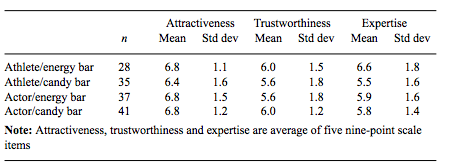This “Healthy Protein” advert features the
Olympic and World champion, Mo Farah, explaining how training a lot and eating
right – including lots of protein (Quorn, in particular) – are key factors in
his success.
The persuasive technique that Quorn is
using here is high status-admirer altercast technique, which is
based on the idea that individuals at the top of the status hierarchy possess a
great degree of influence. Using Mo Farah, admired by many, as an endorser of
the product helps to persuade the audience to purchase the product as the
consumer makes a “secondary association” of the celebrity with the brand
(Keller, 1993). Furthermore, Mo Farah is likely to be viewed as an individual
with high expertise and knowledge in the area of fitness and health, making him
more persuasive to the target audience.
A study carried out by Till and Busler
(1998) looked at the role of expertise in affecting attitudes
towards the endorsed brand. They wanted to test the “match-up hypothesis” (Kamins, 1990), which suggests that
endorsers are more effective when there is a “fit” between the endorser and the
endorsed product. E.g. there is a better “fit” between an athlete and an
athletic product than between an athlete and a non-athletic product.
Participants were provided with a set of
materials describing a particular product (either a chocolate or energy bar),
and information about the endorser of the product (that he was either a “stage
and screen actor” or a “US Olympic track and field athlete”). The endorser was
actually fictitious and created for experimental purposes. Thus, there were 4 conditions (athlete/energy
bar, athlete/chocolate bar, actor/energy bar, actor/chocolate bar). Participants
randomly received one of the four different versions of the materials, and
after viewing them, filled out questions regarding their attitudes, purchase
intent and endorser evaluation.
Table
1 presents the expertise means by condition. As expected, there
was an endorser (actor or athlete) by product (chocolate or energy bar)
interaction, such that the athlete/energy bar combination resulted in the
greatest rating on endorser expertise.
Table 1. Evaluation of endorser means and standard deviations.
Table
2 presents the means for subject’s attitude towards
the product and purchase intent by condition. Attitude ratings towards the
product in the athlete/energy bar condition were significantly higher than the
ratings in the athlete/candy bar condition. The same pattern occurred for
ratings of purchase intent; those in the athlete/energy bar condition were more
likely to purchase the product than those in the athlete/candy bar condition.
Similarly, ratings for the actor/candy bar were higher than ratings in the
actor/energy bar condition in measures of attitude and purchase intent. Thus, there was a match-up effect based on
the expertise of the endorser, suggesting that expertise is an important factor
when matching endorsers with brands.
Table 2. Brand attitude and purchase intent means and standard deviations.
Therefore, Quorn have done a good job of using a
well-known and admired athlete, with high expertise, to sell their product
promoting a healthy eating product. People are more likely to have a positive
attitude toward the product and purchase it, given his knowledge and expertise
within the field of health and fitness.
References
Till, B. D., & Busler, M. (1998). Matching
products with endorsers: attractiveness versus expertise. Journal of Consumer Marketing, 15(6), 576-586.
Kamins, M. A. (1990). An investigation into
the ‘match-up’ hypothesis in celebrity advertising: when beauty may be only
skin deep. Journal of Advertising, 19(1),
4-13.
Keller, K. L. (1993). Conceptualizing,
Measuring, and Managing Customer-Based Brand Equity. Journal of Marketing, 57,
1-22.



No comments:
Post a Comment
Note: Only a member of this blog may post a comment.